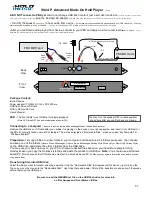
Service
Manual
'41 Models 7800, 7850,
8800 and 9800
1 7 .
MOTOR D O E S HOT S T A R T W it E H A S E L E C T I OH
I S M A D E
OH
T H E E L E C T R I CA L S E L E CT O R
(1 .
GENERAL
In all of the f'ollow1ng
discussions concerning the
failure of �
ne motor to star�,
it is assumed that the selections
were made and that the series re
lay in the electrical selector
has operated.
A
cancellation of
credit is an indication that the
series relP.y has operated.
B.
SOLENOID
eLUNCER
DOES NOT
PUSH. UP
If the solenoid plunger
(fig.
25,
Item
12)
does not push
up, it is probably caused by a
defective coil, or by dirt and
·grease guiwning the plunger and
the solenoid stop pin (Fig.
25,
Item
10)
•
It is also possible
that the selector stop pin may
strike the stop on the rotating
selector disc, which ·.vould pre
vent the solenoid plunger contact
from being raised high enough to
the motor control rel<::y,
timing of motor cQrry over
switch Section 9, paragraph
ncn.)
If the selector solenoid
(F'ig.
25,
Item
11)
ls defective,
it should be replac-ed as dis
cussed under "Operation and
Maintenance."
When the solenoid plunger
and
selector stop pin are stick
ing due to oil or dirt, the
foreign matter should be cleaned
from the moving parts so that
they may slide freely .
These
parts should not be lubrica�ed.
C. Jll.OTOR
CONTROL RELAY DOES NOT
oeERATE PROPF�LY
v.'hen a solenoid plunger is
pushed up, the grooved contact
surface on the lower portion of
the solenoid plunger makes con
tact with the plunger contact
spring (Fig.
2f>,
Item
13)
ai1d
operates the motor control relay.
If the relay does not oper
ate, it may be defective or it
may not be receiving energy.
The
relay receives its energy from
the 25
volt transformer on the
Slllpli.fier.
If the relay operates and
the motor 6.oes
not
run, the motor
is
probably defective or the con
tacts on the motor control relay
are not completing the circuit,
also the motor fuse (Fig.
27,
Item
2)
may be defective.
If the contacts are dirty,
they may be cleaned with
a
burnishing tool.
I f they fail to
make contact, the lower contact
blade may be bent with a contact
bending t-Ool until there is wear
allowance of at least
l/32".
D.
.MOTOR
COifi'ROL CIRCUIT
3 0
Fig.
27
is a schematic dia
gram of the motor control relay
and the Symphonola motor.
This
diagram
is simplified
t o shov1
only the circuit of the motor
control relay and the Symphonola
rootor and is self-explanatory.
Summary of Contents for 7800
Page 40: ...c r f 1 i l r u Z i 33 I 1 1 0 0 00 00 Cl _ 0 0 i ...
Page 44: ...CrSSI S REAR I I Ell CUTAWAY f3 I ll 37 ...
Page 47: ... I iit L 7 8 _ 1 I I I I F I G U R E HO 6 SYM HONf ...
Page 50: ...llll F l GURE H O 7 SYMPHOH II O I ...
Page 57: ...CD w _ _ 0 _ i c a 0 x L I I I L i _ _ _ _ _ ____ _ _ _ _ _ _ _ _ ____ __ _ _ _ _ J 56 ...
Page 73: ...F I G U R E H O 30 SLUG R E J E C T O R Q FRONT 72 ...








































